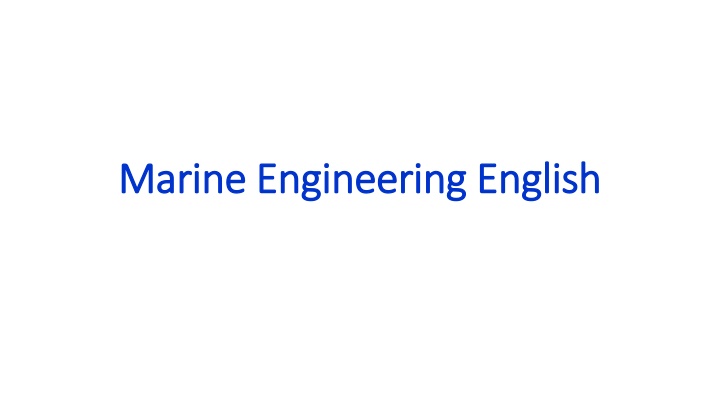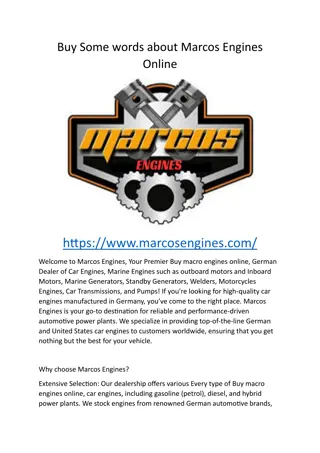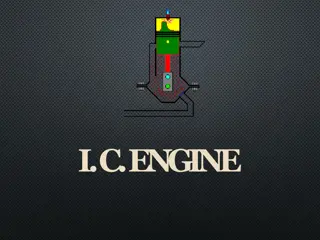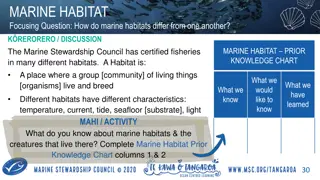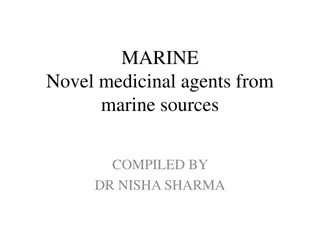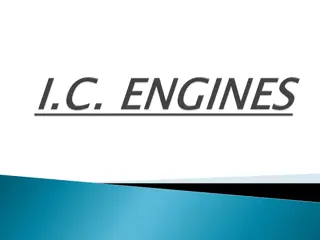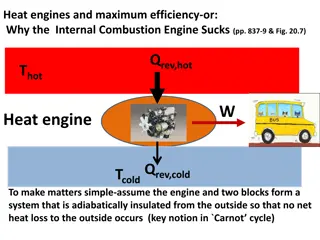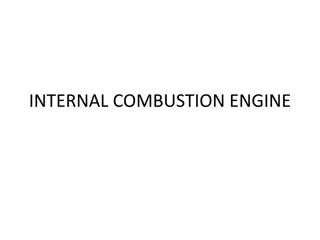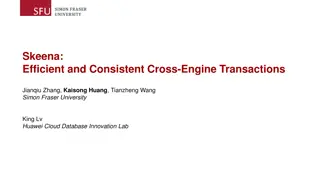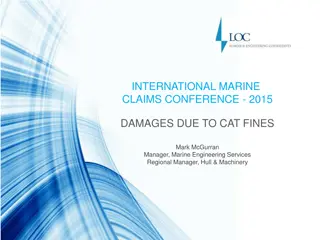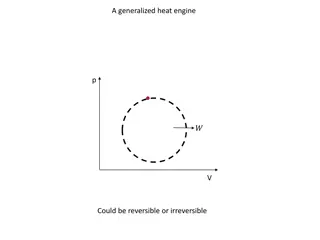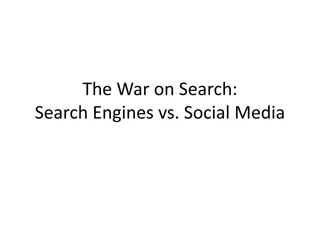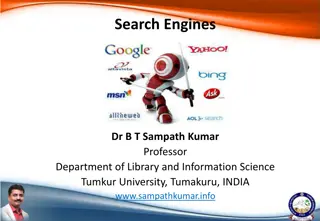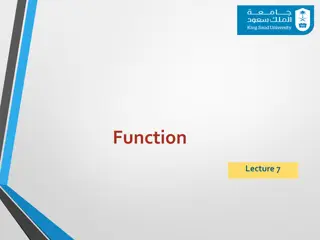Marine Engineering: Functions and Types of Engines
Marine engineering plants are essential for converting fuel energy into useful work to power various ship systems, including propulsion. The primary function of these plants is to utilize chemical energy for steering, lighting, ventilation, air conditioning, heating, refrigeration, and propulsion. The industry heavily relies on crude oil for fuel, with emerging synthetic options. The content also explores the two types of engines used in marine engineering.
Download Presentation

Please find below an Image/Link to download the presentation.
The content on the website is provided AS IS for your information and personal use only. It may not be sold, licensed, or shared on other websites without obtaining consent from the author.If you encounter any issues during the download, it is possible that the publisher has removed the file from their server.
You are allowed to download the files provided on this website for personal or commercial use, subject to the condition that they are used lawfully. All files are the property of their respective owners.
The content on the website is provided AS IS for your information and personal use only. It may not be sold, licensed, or shared on other websites without obtaining consent from the author.
E N D
Presentation Transcript
Marine Engineering English Marine Engineering English
LESSON NINE SHIP PROPULSION
Purpose of marine engineering plants and jobs and duties of marine engineers and ratings 1. 2. 3. 4. 5. 6. 7. etc.
I. I. InternaI and external combustion engines InternaI and external combustion engines The primary function of any marine engineering plant is to convert the chemical energy of fueI into useful work and to employ that power for steering, lighting, ventilating, air conditioning,heating, refrigerating and for work in the propulsion of the ship. Other functions include the production of operation of various types of electrical and electronic devices. Crude oil is, at the present time, the source of most fuel oils for marine use. Synthetic fuels are being developed but will probably be too expensive for ship propusion. SoIid fuel, such as coal used in the first steps of mechanical propulsion, is returning in a small way for certain specialised trade runs. However, the various products of crude oil seem likeIy to remain as the major forms of marine fuel.
Supply the missing words / terms Supply the missing words / terms The primary function of any marine engineering __________ is to convert the chemical energy of fueI into useful work and to employ that power for steering, __________ , ventilating, air __________ , heating, refrigerating and for work in the __________ of the ship. Other functions include the production of operation of various types of electrical and electronic __________ . Crude oil is, at the present time, the source of most fuel oils for __________ use. Synthetic __________ are being developed but will probably be too expensive for ship propusion. __________ fuel, such as coal used in the first steps of mechanical propulsion, is returning in a small way for certain specialised trade runs. However, the various products of __________ seem likeIy to remain as the major forms of marine fuel.
Just as designers and shipbuiIders have to take into consideration the various external forces if they are to build a vessel that will be safe and seaworthy, so they must consider a variety of other factors when estimating what power will be needed to propel the ship through the water. Therefore, the choice of the most suitable power plant depends an the following: the size of the ship, its displacement and deadweight capacity, required speed, length and duration of the voyage, cost and availability of fuel on route used, operational expenses and so an.
Jumbled sentence parts Jumbled sentence parts put them into the right order put them into the right order so they must consider a variety of other factors when estimating what power will be needed to propel the ship through the water. Just as designers and shipbuiIders have to take into consideration the various external forces if they are to build a vessel that will be safe and seaworthy, the size of the ship, its displacement and deadweight capacity, required speed, length and duration of the voyage, cost Therefore, the choice of the most suitable power plant depends an the following: and availability of fuel on route used, operational expenses and so an.
Various types of ship propulsion Various types of ship propulsion: : - - - - - - etc.
There are a number of propelling units fro There are a number of propelling units from mwhich to choose: which to choose: diesel engines, steam turbines, LNG and alternative propulsion, diesel-electric turbo-electric drive, gas turbine and nucear propulsion As for the steam-reciprocating engine, this type of propelling unit is definitely out of date'.
Questions: Questions: - - pair work pair work I. What is the primary function of a marine engineering plant? 2. What is its secondary function? 3. What kind of fuel is used for marine propulsion? What can you say about coal as fuel? 4. What machine is termed external combustion engine? 5. What is an internal combustion engine? 6. What factors must designers and shipbuilders consider when deciding the choice of the propellig unit? 7. What are ther recent developments in marine propulsion
Types of marine propulsion Heat engines
II Complete the diagram below using the information from the text:
II. Types of engines II. Types of engines As it has been said before, there exists a fairly wide range of propulsion units from which to choose, The steam reciprocating engine, the oldest form of mechanical marine propulsion was in regular use for almost two hundred years. In the course of years the machinery was improved and developed compared to its original version, but even with modern refinement such as superheat and re-heat cycle, the steam reciprocating engine has become obsolete: The steam propulsion has been superseded by the steam turbine.
Supply the missing verb Supply the missing verb (also giving the right form Types of engines Types of engines (also giving the right form): ): As it has been _______ before, there _______ a fairly wide range of propulsion units from which to choose, The steam reciprocating engine, the oldest form of mechanical marine propulsion _______ in regular use for almost two hundred years. In the course of years the machinery _______ and developed compared to its original version, but even with modern refinement such as superheat and re-heat cycle, the steam reciprocating engine _______ obsolete: The steam propulsion _______ by the steam turbine.
In the steam reciprocating engine, the up and down movement of the pistons is converted into rotary movement by piston rod and crankshaft. Steam turbines, on the other hand, rotate throughout their operation and with their smoothness (little or no vibration), law weight, minimum space requirements, reliability and low maintenance costs are the first choice for very large main propulsion units. Steam turbines have found application for the propulsion of most supertankers, some fast passenger liners and fast cargo liners such as container ships. A number of vessels are built with diesel-electric or turbo-electric drive. In these ships the power units - steam or diesel - are not used to drive the propeller directly, but to generate electricity for driving the motor coupled to the shaft.
Complete the sentences below Complete the sentences below In the steam reciprocating engine, the up and down movement of the pistons is converted into ............................................ . Steam turbines, ................................., rotate throughout their operation and with their smoothness (little or no vibration), law weight, minimum space requirements, reliability and low maintenance costs they are ....................................................................... . Steam turbines have found ..................................................................., some fast passenger liners and fast cargo liners such as container ships. ............................................... with diesel-electric or turbo-electric drive. In these ships the power units - steam or diesel - are not used to drive the propeller directly, but ...................................................................... .
Cloze test Cloze test - - supply every fifth missing word supply every fifth missing word: : These units have greater ___________ , but against this must ___________ set the increased costs ___________ installation maintenance and operation. ___________ means of propelling a ___________ are the gas turbine ___________ nuclear power. Gas turbine ___________ free piston engines have ___________ used for some fast ___________ craft but their use ___________ not progressed as rapidly ___________ was at one time ___________ likely. Nuclear power has ___________ used in submarines and ___________ few experimental ships incuding ___________ American cargo liner Savannah ___________ it has proved to ___________ , as an uneconomical method ___________ ship drive. Nowadays, the ___________ of nuclear power for ___________ as well as for ___________ application is declining .
Threseunitshavegreaterflexibility, butagainstthismustbesetthe increasedcostsofinstallation,maintenanceandoperation. Othermeansofpropellingashiparethegasturbineandnuclear power. Gas turbineandfreepistonengineshavebeenusedforsomefastnavalcraftbut theirusehasnotprogressedasrapidlyaswasatonetimethoughtlikely. Nuclear power has been used in submarines and a few experimental surface ships including the American cargo liner Savannah but it has proved to be, as yet an uneconomical method of ship drive. Nowadays, the popularity of nuclear power for marine as well as for a shore application is declining.
Questions: Questions: 1. What is the oldest form oj mechanical marine propulsion? How long was it in use? ls the reciprocating steam engine still used for ship propulsion? Say why. What propelling units have replaced today the steam reciprocating engine? What advantages do steam turbines offer if compared to reciprocating engines? What offsets the steam turbine advantages when compared with a diesel engine? Say something about the electric-drive, their advantages and disadvantages. Why haven 't gas turbines, free piston engines and nuclear power enjoyed wide application on merchant vessels? . Why does nuclear power show nowadays a downward trend? 2. 3. 4. 5. 6. 7. 8.
Warm Warm- -up up II. What types of ships make use of the folIowing propelling units? a. steam turbine b. gas turbine c. nuclear power
III. Diesel propulsion III. Diesel propulsion The first merchant ocean-going liner driven by a diesel engine was the Selandia in 1912. The ship was designed for an exceptionally long route, between Copenagen and Bangkok and despite the sceptics' pronouncements that her machinery would prove unreliable and soon wear out, the Selandia was so successful that her owners ceased building steamers. However, it was only after World War II that the diesel s fortune gradually increased extending in the course of time practically to all vessels.
Key words: Key words: - - pair work Underline the keywords in the text Underline the keywords in the text use them in presenting the text to your mate presenting the text to your mate pair work use them in Diesel propulsion The first merchant ocean-going liner driven by a diesel engine was the Selandia in 1912. The ship was designed for an exceptionally long route, between Copenagen and Bangkok and despite the sceptics' pronouncements that her machinery would prove unreliable and soon wear out, the Selandia was so successful that her owners ceased building steamers. However, it was only after World War II that the diesel s fortune gradually increased extending in the course of time practically to all vessels.
Today the great majority of the world fleet is propelled by diesel engines. The reasons for it are manifold. First and foremost the diesel is the most efficient mover from the standpoint of overall thermal efficiency. Fuel consumption is lower than with steamship and consequently less bunker space is required giving added deadweight and cubic capacity for cargo. Diesel engines have good performance at efficient speeds and can be readily reversed for astern operation. Additionally, compared with the steamship, the diesel offers a reduction in size/weight ratio, which faciIitates the diesel machinery being placed aft.
Supply the missing definite article ( Supply the missing definite article (the In some cases the article must be omitted In some cases the article must be omitted the). ). Today ___ great majority of ___ world fleet is propelled by ___ diesel engines. ___ reasons for it are ___ manifold. First and foremost ___ diesel is ___ most efficient mover from ___ standpoint of overall thermal efficiency. Fuel consumption is lower than with ___ steamship and consequently less bunker space is required giving added deadweight and cubic capacity for cargo. ___ diesel engines have good performance at efficient speeds and can be readily reversed for ___ astern operation. Additionally, compared with ___ steamship, ___ diesel offers a reduction in size/weight ratio, which faciIitates ___ diesel machinery being placed aft.
Improvements in marine engineering and in the efficiency of fuel are constantly reducing costs. In recent years engine builders have designed diesel engines capable of using cheaper, heavier boiler oils, instead of the more costly diesel oil. This practice gained impetus in 1973 when fuel cost escalated substantially. Of course, the use of heavy oil for diesels increases the complexity of the plant due to the installation of purifying systems and raises the cost of maintenance, due to its action on pistons and cylinder liners. Nevertheless, the tendency to produce larger, more powerful diesels continues with the purpose of enabling propulsion of ships of larger tonnage.
Complete the sentences below: Complete the sentences below: Improvements in marine engineering and in the efficiency of fuel are ........................................ . In recent years ................................................. capable of using cheaper, heavier boiler oils, instead of the more costly diesel oil. This practice gained impetus in 1973 when ................................ . Of course, the use of heavy oil for diesels increases the complexity of the plant .................................................... and raises the cost of maintenance, due to its action on pistons and cylinder liners. ...................., the tendency to produce larger, more powerful diesels continues with the purpose of ............................................. .
Questions: Questions: 1. Why is the "Selandia" important in the history of marine engineering? Say what you know about her. 2. Enumerate the reasons why today practically all vessels use a diesel drive. 3. Steamships of the past never had their machinery aft; what enables the aft , location of engines on today's vessels? 4. Whata are the principal shortcomings of diesel engines if compared with steam machinery 5. What event, in 1973, deeply influenced marine diesel engines? 6. What direct consequences have the use of heavier oi/s all marine plants and diesel engines? 7. What is the trend of diesel engines today?
II. Exercise II of Lesson 9 provides diagramatically a classification of marine propelling engines at four levels of generality. After you have completed the diagram write as many sentences as you can similar to the examples below: 1. Heat engines are marine propelling engines. 2. The turbo-electric engine is a type of external combustion engine.
Unit 10 DIESEL ENGINES I. Types of diesels
Pair work: Exchange views of the various features of the diesel Exchange views of the various features of the diesel engine engine The diesel engine is a compression ignition engine, that is to say a type of engine in which air is compressed to a pressure sufficient to produce a high temperature ,for spontaneous combustion of the fuel injected into the cylinder at a graduated rate. Diesel engines are used as main propelling machinery and frequently as auxiliary for driving generators to pro vide electric power for shipboard use. There is a wide range in size and type of marine diesels and the differences that mark the various designs regard mainly the following features: operating cycle,
The diesel engine is a compression ignition engine, that is to say a type of engine in which air is compressed to a pressure sufficient to produce a high temperature ,for spontaneous combustion of the fuel injected into the cylinder at a graduated rate. Diesel engines are used as main propelling machinery and frequently as auxiliary for driving generators to pro vide electric power for shipboard use. There is a wide range in size and type of marine diesels and the differences that mark the various designs regard mainly the following features: (1) operating cycle, (2) cylinder arrangement, (3) piston action, (4) piston connection, (5) engine speed, (6) engine drive
Complete the sentences below: Complete the sentences below: ......................................................... diesel engines are divided in two general types known as four-stroke and two-stroke engines. ......................................................... there are two designs: in-line engines or L- engines and V (or Vee)-engines. ......................................................... engines may be cIassed as single-acting, if one side of the piston and one end of the cyIinder are used to develop power, and double-acting, if ........................................................................ . There is another type of engine of British design no longer in use, the 'opposed- piston engine, in which ................................................................. .
Considering the way the piston is attached to the upper end of the connecting rod, we can distinguish two types of diesel engines: the ----- -----------------------, if the piston is directly connected to the rod, and the ---------------------------, if indirectly connected. In the latter type of engine the running gear consists of two additionaI components: the _____________ and _____________ . As for speed, all engines may be divided into three classes: _______________ if they run below 200 rev/min, medium-speed, if ..............................................., and high-speed engines ........................... rpm.
Considering the way the piston is attached to the upper end of the connecting rod, we can distinguish two types of diesel engines: the trunk-piston engine, if the piston is directly connected to the rod, and the crosshead engine, if indirectly connected. In the latter type of engine the running gear consists of two additionaI components: the piston rod and crosshead. As for speed, all engines may be divided into three classes: slow-speed if they run below 200 rev/min, medium-speed, if between 200-750 rev/min and high-speed engines above 750 rpm.
Complete the text below: Complete the text below: (for correct answers check the following slide) According to the way the main engine is joined to the shafting, they may be classified as _______________ , i.e. coupled directly to the propeller shafting (also called direct drive) and _______________, i.e. coupled to a __________ gearing (indirect drive). A final distinction can be made. If engines are designed to rotate in either the clockwise and __________ direction they are known as ____________ engines. If they are not made to run in the opposite direction they are caIIed ____________ or _____________ engines.
According to the way the main engine is joined to the shafting, they may be classified as direct coupled engines, i.e. coupled directly to the propeller shafting (also called direct drive) and geared engines, i.e. coupled to a reduction gearing (indirect drive). A final distinction can be made. If engines are designed to rotate in either the clockwise and anticlockwise direction they are known as direct-reversible engines. If they are not made to run in the opposite direction they are caIIed non-reversible or unidirectional engines.
Questions: Questions: 1. The diesel is defined as a compression ignition engine. What does it mean? 2. Say what diesel engines are used for (a) aboard ships (b) ashore. 3. What is a main engine and what an auxiliary? 4. Is there a standard design of marine diesel able to meet all requirements? 5. Mention the design features that differ diesel engines. 6. What do the terms direct drive and indirect drive refer to? 7. How may engines be classed according to speed? 8. What are unidirectional engines ?
II II. . The diagrams below classify marine diesel The diagrams below classify marine diesel engines. The items at the leve level l ( (I I) represent ) represent the structural features, those of the structural features, those of lower level engines. engines. Complete the diagrams filling in the blank boxes with the suitable Complete the diagrams filling in the blank boxes with the suitable terms. terms. engines. The items at the higher lower level (II) the class of higher (II) the class of
